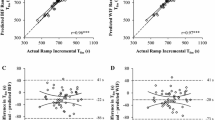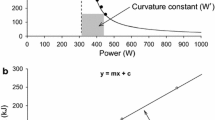Abstract
Introduction
We tested the linear critical power (\(\dot{w}_{\text{cr}}\)) model for discrete incremental ramp exercise implying recovery intervals at the end of each step.
Methods
Seven subjects performed incremental (power increment 25 W) stepwise ramps to subject’s exhaustion, with recovery intervals at the end of each step. Ramps’ slopes (S) were 0.83, 0.42, 0.28, 0.21, and 0.08 W s−1; recovery durations (t r) were 0 (continuous stepwise ramps), 60, and 180 s (discontinuous stepwise ramps). We determined the energy store component (W′), the peak power (\(\dot{w}_{\text{peak}}\)), and \(\dot{w}_{\text{cr}}\).
Results
When t r = 0 s, \(\dot{w}_{\text{cr}}\) and W′ were 187 ± 26 W and 14.5 ± 5.8 kJ, respectively. When t r = 60 or 180 s, the model for ramp exercise provided inconsistent \(\dot{w}_{\text{cr}}\) values. A more general model, implying a quadratic \(\dot{w}_{\text{peak}}\) versus \(\sqrt S\) relationship, was developed. This model yielded, for t r = 60 s, \(\dot{w}_{\text{cr}}\) = 189 ± 48 W and W′ = 18.6 ± 17.8 kJ, and for t r = 180 s, \(\dot{w}_{\text{cr}}\) = 190 ± 34 W, and W′ = 16.4 ± 16.7 kJ. These \(\dot{w}_{\text{cr}}\) and W′ did not differ from the corresponding values for t r = 0 s. Nevertheless, the overall amount of energy sustaining work above \(\dot{w}_{\text{cr}}\), due to energy store reconstitution during recovery intervals, was higher the longer t r, whence higher \(\dot{w}_{\text{peak}}\) values.
Conclusions
The linear \(\dot{w}_{\text{cr}}\) model for ramp exercise represents a particular case (for t r = 0 s) of a more general model, accounting for energy resynthesis following oxygen deficit payment during recovery.




Similar content being viewed by others
Abbreviations
- a :
-
Lumped constant of the intermittent incremental exercise critical power model
- E an :
-
Anaerobic energy stores
- E an(i) :
-
Anaerobic energy restored during the ith recovery
- HR:
-
Heart rate
- i :
-
Ordinal number of the exercise-recovery cycle
- [La]b :
-
Blood lactate concentration
- n :
-
Number of exercise-recovery cycles
- S :
-
Ramp slope
- t :
-
Time
- t lim :
-
Time to exhaustion
- t r :
-
Recovery time
- t s :
-
Step duration
- \(\dot{V}{\text{O}}_{2}\) :
-
Oxygen consumption
- \(\dot{V}{\text{O}}_{{2{\text{cr}}}}\) :
-
Critical metabolic power
- \(\dot{V}{\text{O}}_{{2{\text{max}}}}\) :
-
Maximal oxygen consumption
- \(\dot{V}{\text{O}}_{{2(t_{\text{s}} , i)}}\) :
-
Net \(\dot{V}{\text{O}}_{2}\) attained at the end of the ith exercise step
- W′:
-
Energy store component
- W′def(t) :
-
Time course of the total deficit of W′
- \(W_{{{\text{def(}}t_{\text{r}} ,i )}}^{'}\) :
-
Total deficit of W′ accumulated at the end of the ith recovery
- \(W_{{{\text{def(}}t_{\text{s}} ,i )}}^{'}\) :
-
Total deficit of W′ accumulated at the end of the ith exercise step
- W′ in(i) :
-
Amount of W′ reconstitution during the ith recovery
- W′ out(i) :
-
Amount of W′ erosion during the ith exercise step
- W′ TOT :
-
Total work performed above the critical power
- \(\dot{w}_{\text{cr}}\) :
-
Critical power
- \(\dot{w}_{\text{peak}}\) :
-
Peak power
- \(\alpha\) :
-
Cumulative amount of energy restored at the end of the nth recovery period
- \(\Delta \dot{w}\) :
-
Power increment between successive steps
- \(\Delta \dot{w}_{\text{peak}}\) :
-
Gain in peak power in discontinuous vs continuous incremental exercise
- η :
-
Mechanical efficiency of exercise
- τ :
-
Time constant
References
Adami A, Sivieri A, Moia C, Perini R, Ferretti G (2013) Effects of step duration in incremental ramp protocols on peak power and maximal oxygen consumption. Eur J Appl Physiol 113:2647–2653
Cerretelli P, Pendergast D, Paganelli WC, Rennie DW (1979) Effects of specific muscle training on VO2 on-response and early blood lactate. J Appl Physiol 47:761–769
di Prampero PE (1981) Energetics of muscular exercise. Rev Physiol Biochem Pharmacol 89:143–222
di Prampero PE, Botter A, Osgnach C (2015) The energy cost of sprint running and the role of metabolic power in setting top performances. Eur J Appl Physiol 115:451–469
Ferguson C, Rossiter HB, Whipp BJ, Cathcart AJ, Murgatroyd SR, Ward SA (2010) Effect of recovery duration from prior exhaustive exercise on the parameters of the power-duration relationship. J Appl Physiol 108:866–874
Ferretti G (2015) Energetics of muscular exercise. Springer, Cham
Gaesser GA, Brooks GA (1975) Muscular efficiency during steady-rate exercise: effects of speed and work rate. J Appl Physiol 38:1132–1139
Girardis M, Linnarsson D, Moia C, Pendergast DR, Ferretti G (1999) Oxygen cost of dynamic leg exercise on a cycle ergometer: effects of gravity acceleration. Acta Physiol Scand 166:239–246
Jones AM, Vanhatalo A, Burnley M, Morton RH, Poole DC (2010) Critical power: implications for determination of VO2max and exercise tolerance. Med Sci Sports Exerc 42:1876–1890
Kent-Braun JA, Fitts RH, Christie A (2012) Skeletal muscle fatigue. Compr Physiol 2:997–1044
Margaria R, Oliva RD, Di Prampero PE, Cerretelli P (1969) Energy utilization in intermittent exercise of supramaximal intensity. J Appl Physiol 26:752–756
Monod H, Scherrer J (1965) The work capacity of a synergic muscular group. Ergonomics 8:329–338
Morton RH (1994) Critical power test for ramp exercise. Eur J Appl Physiol Occup Physiol 69:435–438
Morton RH (2011) Why peak power is higher at the end of steeper ramps: an explanation based on the “critical power” concept. J Sports Sci 29:307–309
Morton RH, Billat LV (2004) The critical power model for intermittent exercise. Eur J Appl Physiol 91:303–307
Poole DC, Jones AM (2012) Oxygen uptake kinetics. Compr Physiol 2:933–996
Skiba PF, Fulford J, Clarke DC, Vanhatalo A, Jones AM (2015) Intramuscular determinants of the ability to recover work capacity above critical power. Eur J Appl Physiol 115:703–713
Acknowledgements
The authors thank all the volunteers who participated in this study. This work was supported by Grant No. 2015-1080 from Cariplo Foundation, and by grants of University of Brescia to Guido Ferretti.
Author information
Authors and Affiliations
Corresponding author
Ethics declarations
Conflict of interest
The authors declare that they have no conflict of interest.
Additional information
Communicated by Jean-Rene' Lacour.
Appendix
Appendix
In intermittent exercise, the amount of energy store component (W′) that is used during the ith exercise step above \(\dot{w}_{\text{cr}}\) (W′ out(i)) is, by axiom, the difference between step’s power output and \(\dot{w}_{\text{cr}}\) multiplied for exercise duration (t s):
where i is the step ordinal number, \(\Delta \dot{w}\) is the difference in power between two consecutive steps and i cr is the step ordinal number at \(\dot{w}_{\text{cr}}\) (rounded). Equation (A1) tells that W′ deficit contraction has a linear kinetics, whereas in recovery, W′ is reconstituted following an exponential kinetics, in line with experimental data from literature (Ferguson et al. 2010), according to the following equation:
where \(W_{{{\text{def}}(t_{\text{r}} ,i)}}^{'}\) and \(W_{{{\text{def}}(t_{\text{s}} ,i)}}^{'}\) define, respectively, the total amount of W′ deficit attained at the end of the ith recovery and at the end of the ith exercise step. With these premises, it is possible to calculate the time course of the W′ deficit during the ith exercise step and the ensuing recovery (Fig. 5; Box 1). Incidentally, it is of note that a similar conceptual analysis was proposed by Margaria et al. (1969) for intermittent exercise at constant power of supramaximal intensity. From the algebraic developments in Box 1, it derives that \(W_{{{\text{def}}(t_{\text{s}} ,i)}}^{'}\), for the properties of geometric series is equal to
Time course of the deficit of the energy store component (W′def(t)) during intermittent exercise above the critical power with \(\Delta \dot{w}\) = 25 W, t r = 60 s, t s = 90 s, and W′ = 13 kJ. W′ out(i) and W′ in(i) represent the absolute amount of W′ erosion and reconstitution during the ith exercise-recovery cycle, while \(W_{{{\text{def}}(t_{\text{s}} ,i)}}^{'}\) represents the total deficit attained at the end of an exercise step. Except for the first step, \(W_{{{\text{def}}(t_{\text{s}} ,i)}}^{'} > W_{{{\text{out}}(i)}}^{'}\)
If this is so, then it must exist a theoretical step number (i peak) at which \(W_{{{\text{def}}(t_{\text{s}} ,i)}}^{'}\) is equal to W′ (theoretical because it may be not an integer):
Defining the ramp slope (S) as
we obtain
Equation (A7) is not a function, since any given X value is associated with more than one Y value. However, we can perform the analysis of limit of \(W_{{{\text{def}}(t_{\text{s}} ,i)}}^{'}\) (Equation A3) and re-calculate the corresponding \(\dot{w}_{\text{peak}}\)–S relationship.
When t r → +∞, the \(\dot{w}_{\text{peak}}\)–S relationship becomes equal to the critical power model for continuous constant-power exercise (Monod and Scherrer 1965):
Equation (A9b) corresponds in fact to the second term of Eq. (A7) for t r → +∞, and equivalent to the power output of a single time trial of duration t s.
When t r → 0, the \(\dot{w}_{\text{peak}}\)–S relationship becomes similar to the critical power model for ramp exercise (Morton 1994), with a distortion higher the higher \(\Delta \dot{w}\):
Equation (A9b) corresponds to the critical power model for continuous incremental stepwise exercise. In fact, when \(\Delta \dot{w} \to 0\) (true ramp exercise), it turns out equal to Eq. (5). It can also be derived with the induction process described in Box 1 for t r = 0.
Since the third term of Eq. (A7) increases with increasing \((\dot{w}_{\text{peak}} - \dot{w}_{\text{cr}} )\), and since, when t r → 0, (a) the third term of Eq. (A7) becomes predominant, and (b) \(\dot{w}_{\text{peak}}\) solution is provided by Eq. (A9a), we can oversimplify the third term of Eq. (A7) by assuming that \(\dot{w}_{\text{peak}}\) is always equal to that of Eq. (A9b). This will transform Eq. (A7) into a function:
The error included in Eq. (A10) is negligible (approximately 1 W when 0 < S < 1 W s−1), because \((\dot{w}_{\text{peak}} - \dot{w}_{\text{cr}} )\) becomes significantly greater than \(\sqrt {2 W^{'} S + \frac{1}{4}\Delta \dot{w}^{2} } - \frac{1}{2}\Delta \dot{w}\) only when is t r large, but when t r is large, the third term of the right branch of Eq. (A10) is small. For Eq. (A10), we can affirm that the relationship between \(\dot{w}_{\text{peak}}\) and \(\sqrt S\) for intermittent exercise is the sum of a quadratic and an exponential function, the former being predominant in our investigated t r range.
It is, therefore, demonstrated that in discontinuous incremental stepwise exercise, peak power is a quadratic function of \(\sqrt S\).
Rights and permissions
About this article
Cite this article
Vinetti, G., Fagoni, N., Taboni, A. et al. Effects of recovery interval duration on the parameters of the critical power model for incremental exercise. Eur J Appl Physiol 117, 1859–1867 (2017). https://doi.org/10.1007/s00421-017-3662-5
Received:
Accepted:
Published:
Issue Date:
DOI: https://doi.org/10.1007/s00421-017-3662-5





